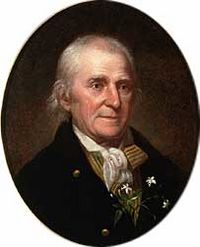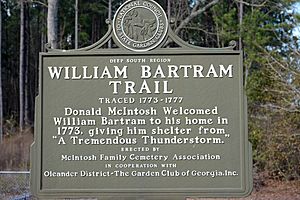William Bartram facts for kids
Quick facts for kids
William Bartram
|
|
|---|---|

Portrait by Charles Willson Peale
|
|
| Born | April 20, 1739 Kingsessing, Philadelphia, Pennsylvania
|
| Died | July 22, 1823 (aged 84) Kingsessing, Philadelphia, Pennsylvania
|
| Known for | Bartram's Travels |
| Parents |
|
| Scientific career | |
| Fields | naturalist |
| Influenced | Linnaeus, Johann Friedrich Gmelin, John Latham |
| Author abbrev. (botany) | W.Bartram |
| Signature | |
William Bartram (born April 20, 1739 – died July 22, 1823) was an American botanist, ornithologist, natural historian, and explorer. He wrote a famous book called Bartram's Travels. This book shared his adventures in the southern British colonies of North America from 1773 to 1777. People have called Bartram "the first naturalist who explored the thick tropical forests of Florida."
Bartram was one of the first bird experts born in America. In 1756, when he was 17, he collected special examples of 14 different American bird species. An English naturalist named George Edwards drew and described these birds in his book Gleanings of Natural History (1760). These descriptions helped other famous scientists like Linnaeus and Johann Friedrich Gmelin to name and classify birds. Bartram also wrote important things about plants. Like his father, he was a member of the American Philosophical Society, joining in 1768.
Contents
Early Life and Family Adventures
William Bartram and his twin sister Elizabeth were born in Kingsessing, Philadelphia, Pennsylvania. Their parents were Ann Bartram and John Bartram, who was also a famous naturalist. As a boy, William often went with his father on trips. They explored places like the Catskill Mountains, the New Jersey Pine Barrens, New England, and Florida.
From his teenage years, William was known for his amazing drawings of plants and birds. He also helped a lot with his father's botanic garden. He added many rare plant species to the garden. In 1756, his father wrote a letter saying that William was drawing many rare birds to send to his friend George Edwards.
Bartram's Big Explorations (1773–1777)
Travels in Georgia

William Bartram arrived in Charleston on March 31, 1773. He found out that a meeting of Native American leaders was planned for June in Augusta, Georgia. He was invited to join a group that would survey new land. After taking care of some business, Bartram traveled to Savannah. He arrived there around April 11 or 12.
While waiting for the meeting to begin, he explored the coast of Georgia. He visited rice farms in Midway and then went to Darien. There, he stayed with Lachlan McIntosh. In his book Travels, Bartram told a story that probably happened in 1776. He met a brave Seminole man in South Georgia. This man had planned to hurt the next white person he saw. But Bartram's friendly attitude changed his mind.
During his coastal trip, Bartram went back to the area of Fort Barrington on the Altamaha River. In 1765, William and his father, John, had found two new trees there. But they didn't have flowers at that time of year. William described these trees in Travels: the Franklin tree (Franklinia alatamaha) and the fevertree (Pinkneya pubens). The Franklin tree has an amazing story. It no longer grows in the wild. All living Franklin trees today come from seeds William Bartram collected.
Bartram then traveled to Augusta. He explored the area while waiting for the Native American meeting to finish. The meeting ended on June 3, 1773, with the Treaty of Augusta. The Creeks and Cherokees gave up 674,000 acres of land in northeast Georgia. This helped them pay off their debts to traders. Bartram joined the group that marked the new boundary.
Bartram returned to Savannah in mid-July. He spent the fall and winter exploring the Altamaha River. He also wrote his report and prepared seeds to send to England.
Travels in Florida
In March 1774, Bartram started his exciting trip to East Florida. He landed on the north end of Amelia Island. He traveled through Old Fernandina to Lord Egmont's plantation. This is where modern Fernandina is today. Bartram was hosted by Stephen Egan, who showed him around the island.
Bartram and Egan sailed from Amelia Island through the Intracoastal Waterway to the St. Johns River. They reached the Cow Ford (Jacksonville), where Bartram bought a small sailboat. Bartram then landed at the plantation of Francis Philip Fatio at Switzerland. He learned about some recent problems at Spalding's Stores. The next day, he stopped at Fort Picolata, where he had tried to be a planter seven years earlier but didn't succeed.
Bartram then stayed on the west bank, which was the Indian shore. The river divided Indian land on the west from English land on the east. He saw a Seminole village where Palatka is now. He was invited to a watermelon feast there that summer. Just south of Palatka, at Stokes Landing, James Spalding built his Lower Store. Bartram made this his base while in Florida. One day, while working, Bartram heard a noise in the nearby Indian camp. He stepped outside and found his Seminole neighbors worried about a large rattlesnake. They asked "Puc Puggy" (Bartram's nickname) to kill the snake, which he did.
In mid-April, Bartram joined Spalding's traders on a trip to Cuscowilla (Micanopy) and Alachua Savannah, now Paynes Prairie Preserve State Park. In late May, Bartram traveled up the St. Johns River. He went to Spalding's Upper Store at present-day Astor and to Blue Spring. Some of the most memorable parts of Travels happened on this river trip. A wolf stole his fish while he slept. Alligators bothered and threatened him while he was fishing from his boat. He also saw a fight between two huge alligators.
During the summer, Bartram made another trip to Alachua Savannah and to the Suwannee River. He traveled up the St. Johns River one last time in September. He left Florida for good in November 1774.
Exploring the Cherokee Nation

On April 22, 1775, Bartram left Charleston, South Carolina, on horseback. He wanted to explore the Cherokee Nation. He passed through Augusta on May 10. A few days later, he left Fort Prince George and Keowee after not being able to find a guide.
Return to Philadelphia and Famous Book
Bartram returned to Philadelphia in January 1777. He helped his brother John with everything at Bartram's Garden. In the late 1780s, he finished his most famous book, Travels through North and South Carolina, Georgia, East and West Florida, the Cherokee Country, etc. At the time, it was considered one of the best books about American natural history.
Many of Bartram's descriptions of historical places were the first ever recorded. This included the Georgia mound site of Ocmulgee. Besides adding to scientific knowledge, Travels is known for its beautiful descriptions of the American countryside. Bartram's writing influenced many Romantic writers of his time. Famous writers like William Wordsworth and Samuel Taylor Coleridge read his book. You can see its influence in many of their works.
Even though some people thought Bartram was a loner, he stayed active in business, science, and learning well into the 1800s. He taught his nieces and nephews. He wrote many essays and helped with other works without his name on them. He also helped run the family's plant business. In 1802, Bartram met a teacher named Alexander Wilson. Bartram taught him the basics of ornithology (the study of birds) and how to draw nature. Wilson's book American Ornithology mentions Bartram many times.
After the War of 1812, many of his friends and colleagues had passed away. Bartram then spent a long time working, observing, and studying at his family's garden in Kingsessing. He kept a "Diary" where he wrote about bird migrations, plant life, and the weather. He turned down an offer to teach botany at the University of Pennsylvania. In his sixties, he also said no to an invitation from President Thomas Jefferson. Jefferson wanted him to join an expedition up the Red River in the Louisiana Territory in 1806.
Later Life and Death
Bartram died at his home in 1823, when he was 84 years old. A short biography by Robert Carr says, "He wrote an article on the natural history of a plant a few minutes before his death." This shows he loved nature until his very last moments.
Places Named After William Bartram
Many places and sites are named in his honor:
- The Bartram Trail: A hiking trail in North Carolina, Georgia, and South Carolina that remembers his journeys.
- The Bartram Canoe Trail: A system of canoe and kayak trails in the Mobile-Tensaw River Delta.
- William Bartram Scenic & Historic Highway: Part of Florida State Road 13 that runs along the east side of the St. Johns River in Florida.
- Bartram Trail High School in St. Johns, Florida.
- Bartram Trail Elementary School and Bartram Springs Elementary School in Jacksonville, Florida.
- The William Bartram Arboretum: Located within Fort Toulouse Park, near Wetumpka, Alabama.
- Bartram Hall: A building on the University of Florida campus in Gainesville, Florida.
- Bartram Trail Regional Library System in east Georgia.
- Bartram's bass, or redeye bass (Micropterus coosae): A fish species found only in the Savannah River area in Georgia.
- The Upland Sandpiper (Bartramia Longicauda): This bird's scientific genus name comes from William Bartram.
Bartram died on July 22, 1823, at Bartram's Garden.
See also
 In Spanish: William Bartram para niños
In Spanish: William Bartram para niños


